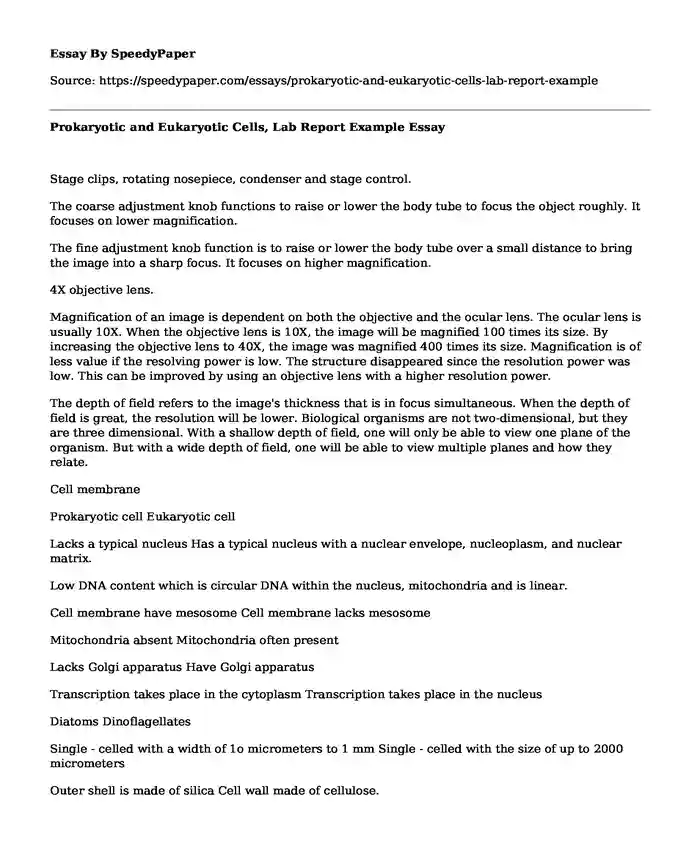Stage clips, rotating nosepiece, condenser and stage control.
The coarse adjustment knob functions to raise or lower the body tube to focus the object roughly. It focuses on lower magnification.
The fine adjustment knob function is to raise or lower the body tube over a small distance to bring the image into a sharp focus. It focuses on higher magnification.
4X objective lens.
Magnification of an image is dependent on both the objective and the ocular lens. The ocular lens is usually 10X. When the objective lens is 10X, the image will be magnified 100 times its size. By increasing the objective lens to 40X, the image was magnified 400 times its size. Magnification is of less value if the resolving power is low. The structure disappeared since the resolution power was low. This can be improved by using an objective lens with a higher resolution power.
The depth of field refers to the image's thickness that is in focus simultaneous. When the depth of field is great, the resolution will be lower. Biological organisms are not two-dimensional, but they are three dimensional. With a shallow depth of field, one will only be able to view one plane of the organism. But with a wide depth of field, one will be able to view multiple planes and how they relate.
Cell membrane
Prokaryotic cell Eukaryotic cell
Lacks a typical nucleus Has a typical nucleus with a nuclear envelope, nucleoplasm, and nuclear matrix.
Low DNA content which is circular DNA within the nucleus, mitochondria and is linear.
Cell membrane have mesosome Cell membrane lacks mesosome
Mitochondria absent Mitochondria often present
Lacks Golgi apparatus Have Golgi apparatus
Transcription takes place in the cytoplasm Transcription takes place in the nucleus
Diatoms Dinoflagellates
Single - celled with a width of 1o micrometers to 1 mm Single - celled with the size of up to 2000 micrometers
Outer shell is made of silica Cell wall made of cellulose.
Cannot move through water, some form long chains, or have spines for floating n water Have flagella to aid I movement through water
They are strictly autotrophs, meet their nutritional requirements from photosynthesis They are autotroph but Some species are heterotrophs - absorbs organic matter or engulfment of the prey.
The onion cells are smooth and slim while the elodea cells are more square and bigger. Elodea cells have chloroplasts while onions do not. Onions are the storage organ, and they grow underground, and they lack access to sunlight hence lack chloroplasts while elodea cells require chlorophyll to synthesize ATP from the sun.
Eukaryotic cells evolved from prokaryotic cells through endosymbiosis. Most eukaryotic cell parts were made from prokaryotic cells. The evolution helped the new forms of the cell to adapt to the new atmosphere which now had oxygen. For example, the mitochondria, and chloroplast was a prokaryote that became engulfed by a primitive eukaryote but not digested. Once they became part of a prokaryote, they were now able to synthesize their food.
Cite this page
Prokaryotic and Eukaryotic Cells, Lab Report Example. (2022, Mar 11). Retrieved from https://speedypaper.net/essays/prokaryotic-and-eukaryotic-cells-lab-report-example
Request Removal
If you are the original author of this essay and no longer wish to have it published on the SpeedyPaper website, please click below to request its removal:
- Free Essay on Whether Today's Youth Are More Self-Centred Than Previous Generations
- Business Statistics Essay Sample
- Healthcare Essay Sample: Stroke Education and African American Women
- 61-69 Alpha Synuclein Essay Example
- Critical Analysis of Poetry - Free Essay on Phenomenal Woman and Barbie Doll
- Understanding Crime in the Society, Essay Example for Students
- Essay Sample on How Social Media Has Increased Depression and Anxiety in Teenagers
Popular categories





